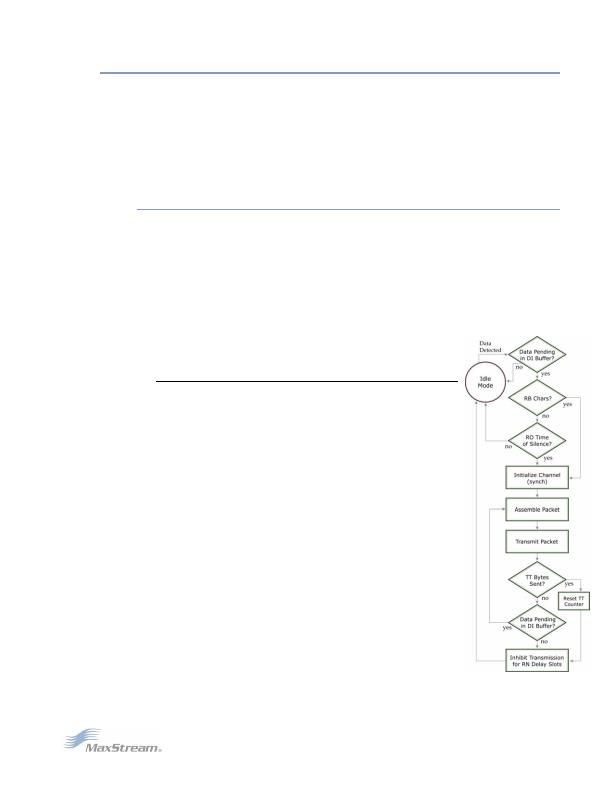- 您現(xiàn)在的位置:買賣IC網(wǎng) > Datasheet目錄58 > XIB-E (Digi International/Maxstream)BOARD INTERFACE ETHERNET Datasheet資料下載
參數(shù)資料
| 型號: | XIB-E |
| 廠商: | Digi International/Maxstream |
| 文件頁數(shù): | 37/64頁 |
| 文件大小: | 1858K |
| 描述: | BOARD INTERFACE ETHERNET |
| 標準包裝: | 1 |
| 附件類型: | 接口板 |
| 適用于相關(guān)產(chǎn)品: | XStream 和 Xcite 收音機 |
第1頁第2頁第3頁第4頁第5頁第6頁第7頁第8頁第9頁第10頁第11頁第12頁第13頁第14頁第15頁第16頁第17頁第18頁第19頁第20頁第21頁第22頁第23頁第24頁第25頁第26頁第27頁第28頁第29頁第30頁第31頁第32頁第33頁第34頁第35頁第36頁當(dāng)前第37頁第38頁第39頁第40頁第41頁第42頁第43頁第44頁第45頁第46頁第47頁第48頁第49頁第50頁第51頁第52頁第53頁第54頁第55頁第56頁第57頁第58頁第59頁第60頁第61頁第62頁第63頁第64頁

XStream"燨EM燫F燤odule?燩roduct燤anual爒5.x00燵2006.02.24]?/DIV>
4.2. Basic Communications
Basic Communications are accomplished through two sub-types:
" Broadcast - By default, XStream Modules communicate through Broadcast communications
and within a peer-to-peer network topology. When any module transmits, all other modules
within range will receive the data and pass it directly to their host device.
" Addressed - If addressing parameters match, received RF data is forwarded to the DO (Data
Out) buffer; otherwise, the RF data is discarded.
When using Basic Communications, any functions such as acknowledgements are handled at the
application layer by the OEM/integrator. The Broadcast Modes provide transparent
communications, meaning that the RF link simply replaces a wired link.
4.2.1. Streaming Mode (Default)
Characteristics: Highest data throughput
Lowest latency and jitter
Reduced immunity to interference
Transmissions never acknowledged (ACK) by receiving module(s)
Required Parameter Values (TX Module): RR (Retries) = 0
Related Commands: Networking (DT, MK, MY), Serial Interfacing (PK, RB, RO, TT)
Recommended Use: Mode is most appropriate for data systems more sensitive to latency
and/or jitter than to occasional packet loss. For example: streaming audio or video.
Streaming Mode Data Flow
Figure?04. Streaming燤ode燬tate燚iagram?TX燤odule)牋
Events & processes in this mode are common to all of the other RF
Modes.
NOTE: When streaming data, RB and RO parameters are only observed on
the first packet.
After transmission begins, the TX event will continue uninterrupted until
the DI buffer is empty or the streaming limit (TT Command) is reached.
As with the first packet, the payload of each subsequent packet includes
up to the maximum packet size (PK Command).
The streaming limit (TT Command) is specified by the transmitting
module as the maximum number of bytes the transmitting module can
send in one transmission event. After the TT parameter threshold is
reached, the transmitting module will force a random delay of 1 to RN
delay slots (exactly 1 delay slot if RN = 0).
Subsequent packets are sent without an RF initializer since receiving
modules stay synchronized with the transmitting module for the
duration of the transmission event (from preceding packet information).
However, due to interference, some receiving modules may lose data
(and synchronization to the transmitting module), particularly during
long transmission events.
Once the transmitting module has sent all pending data or has reached
the TT limit, the transmission event ends. The transmitting module will
not transmit again for exactly RN delay slots if the local (i.e.
transmitting modules) RN parameter is set to a non-zero value. The
receiving module(s) will not transmit for a random number of delay s
between 0 and (RN-1) if the local (i.e. receiving modules) RN
parameter is set to a non-zero value. These delays are intended to lessen congestion following
long bursts of packets from a single transmitting module, during which several receiving modules
may have become ready to transmit.
lots
牋牘?006燤axStream,營nc.燙onfidential燼nd燩roprietary?/DIV>
37?/DIV>
相關(guān)PDF資料 |
PDF描述 |
|---|---|
| XIB-R | BOARD INTERFACE RS232/485 |
| ZMN2400HPDB | BOARD ROUTER DEV ZIGBEE 100MW |
| ZMN24HPDK-B | KIT DEV W/ZIGBEE ZMN2400HP |
| ZNI1000TC | IC TEMP SENSOR NI1000 SOT23-3 |
| 02110102-000 | SNSR TILT RATIO 60DEG 500MA FLNG |
相關(guān)代理商/技術(shù)參數(shù) |
參數(shù)描述 |
|---|---|
| XIB-R | 功能描述:界面模塊 RS-232/485 interface 24XStream 9XCite RoHS:否 制造商:4D Systems 產(chǎn)品:Serial Converters 通道/端口數(shù)量: 數(shù)據(jù)速率: 接口類型:USB, UART 工作電源電壓:3.3 V, 5 V 最大工作溫度: |
| XIB-U | 功能描述:界面模塊 USB interface board 24XStream 9XCite RoHS:否 制造商:4D Systems 產(chǎn)品:Serial Converters 通道/端口數(shù)量: 數(shù)據(jù)速率: 接口類型:USB, UART 工作電源電壓:3.3 V, 5 V 最大工作溫度: |
| XIC25040 | 制造商:XIC 功能描述:25040 24HR '6 |
| XILINXPWR-079 | 功能描述:電源管理IC開發(fā)工具 Pow Mgt Eval Mod for Xilinx FPGAs RoHS:否 制造商:Maxim Integrated 產(chǎn)品:Evaluation Kits 類型:Battery Management 工具用于評估:MAX17710GB 輸入電壓: 輸出電壓:1.8 V |
| XILINXPWR-080 | 功能描述:電源管理IC開發(fā)工具 Pow Mgt Eval Mod for Xilinx FPGAs RoHS:否 制造商:Maxim Integrated 產(chǎn)品:Evaluation Kits 類型:Battery Management 工具用于評估:MAX17710GB 輸入電壓: 輸出電壓:1.8 V |
發(fā)布緊急采購,3分鐘左右您將得到回復(fù)。